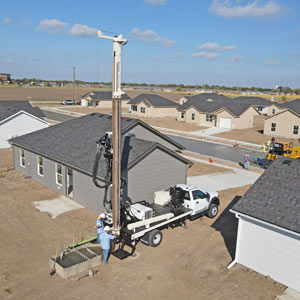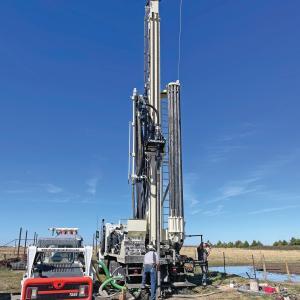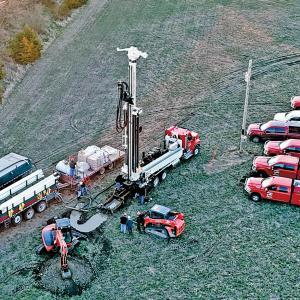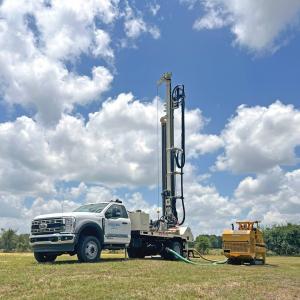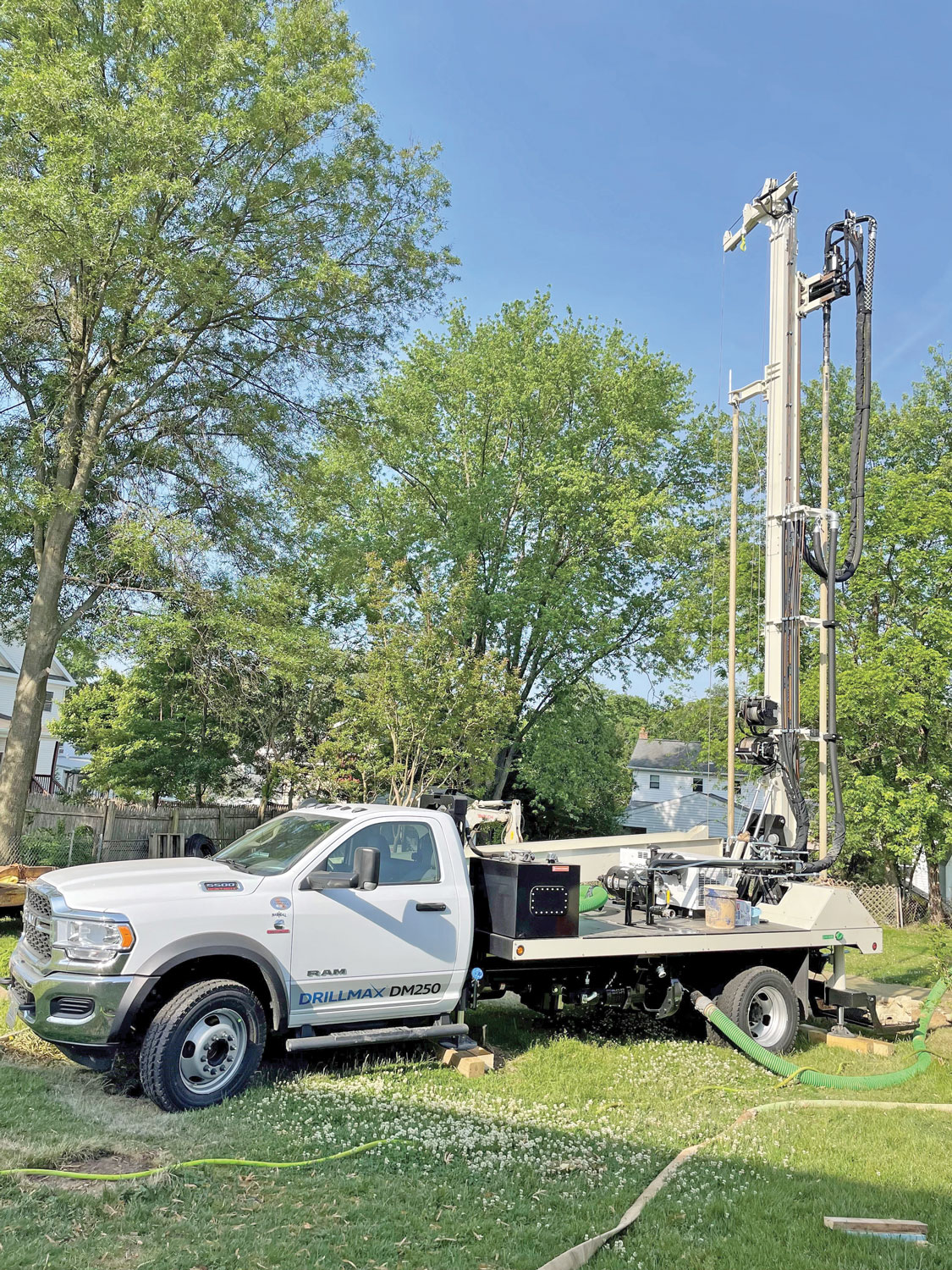
Purchased for its mud rotary capabilities, the DM250 performs air rotary drilling rock wells in palm-sized cobbles using an auxiliary air compressor.
Spending summers working for his father’s drilling business in Virginia, Scott Miller earned an electrical engineering degree and worked for Lockheed Martin in Alabama until his father’s controller retired in 2000.
“My father asked if I knew anyone good he could trust to do the position,” Miller said. “He never asked or expected me to take over the company. I loved my job at Lockheed, but I was traveling all the time.”
Having already contemplated starting his own IT business, he moved back to Virginia, started his business, and for three years did his father’s books on the side. He discovered it was no part-time job.
“I did his office work and ran my own business and knew I couldn’t continue doing both. I liked working to keep employees happy and employed and knew I could be home in the evenings,” Miller said.
So he gave up his IT company, hired a controller, and took over the three department Northern Virginia Drilling. His brother runs their blast hole drilling department while Scott runs the water well and geothermal departments.
“I’ve drilled, installed pumps, done filtrations, and fused geothermal pipe in the ditch. If it’s a large commercial job, I’m usually on site,” Miller said. “All my drillers are smoother than me because they’re doing it every day, but I’m usually pretty good about helping solve problems if they run into a snag.”
The company focused on water well and blasthole when they began in 1988, but around 2006 they got into geothermal.
“This was a blessing when the housing market burst. From 2007-15 we did as much geothermal as anything else,” Miller said.
FROM AIR ROTARY DRILLING TO MUD ROTARY
The company has 15 drill rigs performing air drilling in rock formations. Increasingly they received requests requiring mud rotary.
“We kept getting requests — too many to continue to ignore,” Miller said. “So we started doing auxiliary mud pump, but it wasn’t efficient. We needed something affordable with more mud rotary ability. We asked around and most steered us toward DRILLMAX® by Geoprobe®.”
Now their only mud rotary drill rig is a DRILLMAX® DM250 by Geoprobe®.
“We looked at other options, but they were more electric over hydraulic, which to me is just a lot more stuff to fail,” Miller said. “They were also more expensive but not more capable.”
While they bought the DM250 for its mud rotary abilities, they’ve found it to be very capable of completing air rotary drilling with an auxiliary air compressor to run the down hole hammer.
“They didn’t tell us its limitations, so we’ve been putting it to the test,” Miller said. “We thought we’d only be running it 70 percent of the time, but it has stayed busy every day.”
FROM MUD TO AIR ROTARY DRILLING
They’ve installed two, 500-foot rock wells — one 6 inch and another 4 inch. The 6-inch well required surface casing, so they did 10-inch mud rotary to 200 feet and set the 6-inch steel casing.
“We just decided to see what the DM250 could do, so pulled in an auxiliary air compressor and used a 6-inch hammer to complete the 6-inch well pulling 12 gallons/minute,” Miller said.
They went into the 4-inch well job planning purely mud rotary.
“We’d done the neighbor’s well to 200 feet using mud, but when we moved over, there was no water. So we set 280 feet of surface casing and used a 3-inch hammer to drill into the rock with a 4-inch bit,” Miller said. “The DM250 could do it every day if we wanted.”
INCREASED EFFICIENCY
The small DM250 efficiently completes the 500-foot wells.
“We can go that deep with a single axle, non-CDL truck and pull 500 feet of rod,” Miller said. "It's small, but can run 20-foot rods. There are other small rigs, but they only run 10-foot tooling."
Accustomed to using 250 gallons of fuel per day with their large air rotary drilling rigs, the fuel efficiency of the compact DM250 is a bonus.
“With mud rotary on DM250 we’re using 25 gallons/day. Our fuel bill is a lot less,” Miller said. “Plus the compact, 4-wheel drive is easier on and off muddy sites. With no CDL required, any employee can drive it.”
SIMPLE SERVICE
According to Miller, universally-sourced parts make for simple service.
“If you need a certain bearing or fitting you can get them locally," Miller said. “Plus it’s easy to work on with everything out in the open.”
Having a fleet of foreign-made air rigs, Miller said he appreciates the DM250 being manufactured in Kansas.
“It’s made in the USA so we’re not paying a fortune on parts,” Miller said. “You can always reach someone on the phone or via text.”
For Miller, parts inventory and support are where other companies come up short.
“We also like that DRILLMAX® has Geoprobe® as a parent company. We knew we’d have somebody to help keep inventory and provide support out in the field,” Miller said. “They’re established with support infrastructure. I don’t care what kind of drill you have, it’s going to breakdown so it’s about how fast you can get back up and running.”
Contact Us
1835 Wall Street
Salina, Kansas 67401
Phone: (785) 825-1842
Photo Gallery


Related Articles
Rig service technicians work quickly to make precise repairs, knowing downtime affects the business.
ID: 14622 | Date:
Service technicians offer onsite repairs or over the phone troubleshooting.
ID: 14621 | Date:
With dual centrifugal pumps and the ability to upream, DM650 has power and speed to tackle deep western Kansas wells.
ID: 14594 | Date:
DM650 pipe handling and backloading carousel make big-diameter wells faster, easier, and safer for crews.
ID: 14593 | Date:
From one rig to two in less than a year, DM250 holdback and carousel help keep Texas-based water well business running fast and efficient.
ID: 14591 | Date:
Related Videos
DM Water Well Rig Series Overview
ID: 14052
Geoprobe® Walkaround: DM650 Air Rig
ID: 14045
ID: 14042
ID: 14040


